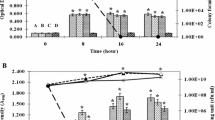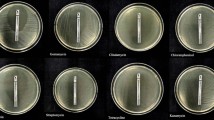Abstract
We assessed the safety and biotechnological properties of 17 Enterococcus faecalis and 18 Enterococcus faecium strains isolated from Meju to select starter candidates for quality Meju production. Minimum inhibitory concentration assays showed that all strains were susceptible to ampicillin, chloramphenicol, ciprofloxacin, erythromycin, gentamicin, penicillin G, and tetracycline, as judged by the breakpoint values defined at the species level by the European Committee on Antimicrobial Susceptibility Testing, whereas two E. faecalis strains were resistant to vancomycin, which could be ascribed to acquired resistance. None of the strains exhibited α- or β-hemolytic activities or biofilm formation. Both species showed similar levels of biogenic amine production, and noticeable amounts of tyramine (3397.4 ± 172.4 ppm) were produced by all strains in the presence of precursors (histidine, lysine, ornithine, and tyrosine). All strains exhibited protease, lipase, and acid production, with decreased activity observed with increasing NaCl concentrations. This study confirmed the necessity of antibiotic resistance screening of Enterococcus species for food production, with the identification of vancomycin-resistant strains from Meju.

Similar content being viewed by others
References
Adams MR (1999) Safety of industrial lactic acid bacteria. J Biotechnol 68:171–178
Aguirre M, Collins MD (1993) Lactic acid bacteria and human clinical infection. J Appl Bacteriol 75:95–107
Bhardwaj A, Malik RK, Chauhan P (2008) Functional and safety aspects of enterococci in dairy foods. Indian J Microbiol 48:317–325
Bover-Cid S, Holzapfel WH (1999) Improved screening procedure for biogenic amine production by lactic acid bacteria. Int J Food Microbiol 53:33–41
Carelli D, Centonze D, Palermo C, Quinto M, Rotunno T (2007) An interference free amperometric biosensor for the detection of biogenic amines in food products. Biosens Bioelectron 23:640–647
Cho TY, Han G-H, Bahn KN, Son Y-W, Jang M-R, Lee C-H, Kim S-H, Kim D-B, Kim S-B (2006) Evaluation of biogenic amines in Korean commercial fermented foods. Korean J Food Sci Biotechnol 38:730–737
CLSI (2007) Performance standards for antimicrobial susceptibility testing; seventeenth informational supplement. CLSI document M100-S17. Clinical and Laboratory Standards Institute, Wayne
de Las Rivas B, Marcobal A, Munoz R (2005) Improved multiplex-PCR method for the simultaneous detection of food bacteria producing biogenic amines. FEMS Microbiol Lett 244:367–372
Domann E, Hain T, Ghai R, Billion A, Kuenne C, Zimmermann K, Chakraborty T (2007) Comparative genomic analysis for the presence of potential enterococcal virulence factors in the probiotic Enterococcus faecalis strain Symbioflor 1. Int J Med Microbiol 297:533–539
Endtz HP, van den Braak N, Verbrugh HA, van Belkum A (1999) Vancomycin resistance: status quo and quo vadis. Eur J Clin Microbiol Infect Dis 18:683–690
Fifadara N, Radu S, Hassan Z, Beuchat LR, Rusul G (2003) Hemolytic and nonhemolytic vancomycin-resistant Enterococcus faecalis isolated from beef imported to Malaysia. J Food Prot 66:1845–1850
Franz CM, Holzapfel WH, Stiles ME (1999) Enterococci at the crossroads of food safety? Int J Food Microbiol 47:1–24
Franz CM, Huch M, Abriouel H, Holzapfel W, Galvez A (2011) Enterococci as probiotics and their implications in food safety. Int J Food Microbiol 151:125–140
Gardiner GE, Ross RP, Wallace JM, Scanlan FP, Jagers PP, Fitzgerald GF, Collins JK, Stanton C (1999) Influence of a probiotic adjunct culture of Enterococcus faecium on the quality of cheddar cheese. J Agric Food Chem 47:4907–4916
Halasz A, Barath A, Sarkadi LS, Holzapfel W (1994) Biogenic amines and their production by microorganisms in food. Trends Food Sci Tech 5:42–49
Heilmann C, Schweitzer O, Gerke C, Vanittanakom N, Mack D, Gotz F (1996) Molecular basis of intercellular adhesion in the biofilm-forming Staphylococcus epidermidis. Mol Microbiol 20:1083–1091
Hidron AI, Edwards JR, Patel J, Horan TC, Sievert DM, Pollock DA, Fridkin SK, National Healthcare Safety Network T, Participating National Healthcare Safety Network F (2008) NHSN annual update: antimicrobial-resistant pathogens associated with healthcare-associated infections: annual summary of data reported to the National Healthcare Safety Network at the Centers for Disease Control and Prevention, 2006–2007. Infect Control Hosp Epidemiol 29:996–1011
Hwang DF, Chang SH, Shiua CY, Chai T (1997) High-performance liquid chromatographic determination of biogenic amines in fish implicated in food poisoning. J Chromatogr B Biomed Sci Appl 693:23–29
Jeong DW, Cho H, Lee H, Li C, Garza J, Fried M, Bae T (2011) Identification of the P3 promoter and distinct roles of the two promoters of the SaeRS two-component system in Staphylococcus aureus. J Bacteriol 193:4672–4684
Jeong DW, Kim HR, Han S, Jeong CO, Lee JH (2013) A proposal to unify two subspecies of Staphylococcus equorum: Staphylococcus equorum subsp. equorum and Staphylococcus equorum subsp. linens. Antonie van Leeuwenhoek 104:1049–1062
Jeong DW, Han S, Lee JH (2014a) Safety and technological characterization of Staphylococcus equorum isolates from jeotgal, a Korean high-salt-fermented seafood, for starter development. Int J Food Microbiol 188:108–115
Jeong DW, Kim HR, Jung G, Han S, Kim CT, Lee JH (2014b) Bacterial community migration in the ripening of doenjang, a traditional Korean fermented soybean food. J Microbiol Biotechnol 24:648–660
Jung JY, Lee SH, Jeon CO (2014) Microbial community dynamics during fermentation of doenjang-meju, traditional Korean fermented soybean. Int J Food Microbiol 185:112–120
Kim D-Y, Kwon D-J (2014) Quality characteristics of Doenjang manufactured with soybean Koji. Korean J Food Preserv 21:434–441
Kim J-H, Ahn H-J, Yook H-S, Park HJ, Byun M-W (2001) Biogenic amines contents in commercial Korean traditional fremented soybean paste. Korean J Food Sci Biotechnol 33:682–685
Kim JH, Yoo JS, Lee CH, Kim SY, Lee SK (2006) Quality properties of soybean pastes made from meju with mold producing protease isolated from traditional meju. J Korean Soc Appl Biol Chem 49:7–14
Kim D-Y, Park G-Y, Jang S-W, Hong S-C, Kown D-J (2013) Establishment of optimal soybean Koji manufacturing conditions. Korean J Food Preserv 20:379–385
Lina G, Quaglia A, Reverdy ME, Leclercq R, Vandenesch F, Etienne J (1999) Distribution of genes encoding resistance to macrolides, lincosamides, and streptogramins among staphylococci. Antimicrob Agents Chemother 43:1062–1066
Martin B, Garriga M, Hugas M, Aymerich T (2005) Genetic diversity and safety aspects of enterococci from slightly fermented sausages. J Appl Microbiol 98:1177–1190
Nam YD, Lee SY, Lim SI (2012) Microbial community analysis of Korean soybean pastes by next-generation sequencing. Int J Food Microbiol 155:36–42
Patel G, Snydman DR, AST Infectious Diseases Community of Practice (2013) Vancomycin-resistant Enterococcus infections in solid organ transplantation. Am J Transpl 4:59–67
Perez-Pulido R, Abriouel H, Ben Omar N, Lucas R, Martinez-Canamero M, Galvez A (2006) Safety and potential risks of enterococci isolated from traditional fermented capers. Food Chem Toxicol 44:2070–2077
Perin LM, Miranda RO, Todorov SD, de Melo Franco BDG, Nero LA (2014) Virulence, antibiotic resistance and biogenic amines of bacteriocinogenic lactococci and enterococci isolated from goat milk. Int J Food Microbiol 185:121–126
Pinheiro ET, Gomes BPFA, Drucker DB, Zaia AA, Ferraz CCR, Souza-Filho FJ (2004) Antimicrobial susceptibility of Enterococcus faecalis isolated from canals of root filled teeth with periapical lesions. Int Endod J 37:756–763
Santos MM, Piccirillo C, Castro PM, Kalogerakis N, Pintado ME (2012) Bioconversion of oleuropein to hydroxytyrosol by lactic acid bacteria. World J Microbiol Biotechnol 28:2435–2440
Shalaby AR (1996) Significance of biogenic amines to food safety and human health. Food Res Int 29:675–690
Shukla S, Park HK, Kim JK, Kim M (2010) Determination of biogenic amines in Korean traditional fermented soybean paste (Doenjang). Food Chem Toxicol 48:1191–1195
Sila Santos MH (1996) Biogenic amines: their importance in foods. Int J Food Microbiol 29:213–231
Zheng B, Tomita H, Inoue T, Ike Y (2009) Isolation of VanB-type Enterococcus faecalis strains from nosocomial infections: first report of the isolation and identification of the pheromone-responsive plasmids pMG2200, Encoding VanB-type vancomycin resistance and a Bac41-type bacteriocin, and pMG2201, encoding erythromycin resistance and cytolysin (Hly/Bac). Antimicrob Agents Chemother 53:735–747
Acknowledgments
This research was supported by the Basic Science Research Program through the National Research Foundation of Korea (NRF) funded by the Ministry of Education (NRF-2014R1A1A2057003).
Author information
Authors and Affiliations
Corresponding author
Additional information
Miran Jeong and Do-Won Jeong have contributed equally to this work.
Rights and permissions
About this article
Cite this article
Jeong, M., Jeong, DW. & Lee, JH. Safety and biotechnological properties of Enterococcus faecalis and Enterococcus faecium isolates from Meju . J Korean Soc Appl Biol Chem 58, 813–820 (2015). https://doi.org/10.1007/s13765-015-0110-2
Received:
Accepted:
Published:
Issue Date:
DOI: https://doi.org/10.1007/s13765-015-0110-2




